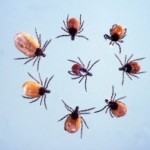 A novel vaccine for Lyme disease led to the production of antibodies against the borrelia organisms that cause the disease in the U.S. and Europe, without sparking major side effects, according to new research. The vaccine must undergo Phase III trials, but the research team is hopeful it will become a tool to help prevent Lyme disease in people. Dogs and humans contract Lyme disease from ticks, and the incidence of Lyme disease in the U.S. is increasing. Medical News Today (5/14)
A novel vaccine for Lyme disease led to the production of antibodies against the borrelia organisms that cause the disease in the U.S. and Europe, without sparking major side effects, according to new research. The vaccine must undergo Phase III trials, but the research team is hopeful it will become a tool to help prevent Lyme disease in people. Dogs and humans contract Lyme disease from ticks, and the incidence of Lyme disease in the U.S. is increasing. Medical News Today (5/14)
A vaccine for Lyme disease may be on its way, following a promising phase 1/2 clinical trial from investigators at the Stony Brook University School of Medicine and Brookhaven National Laboratory.
The finding was published online in The Lancet Infectious Diseases, and revealed that the vaccine resulted in significant antibodies against all targeted species of Borrelia – the agent that causes Lyme disease in the United States and Europe.
Lyme disease, contracted via ticks, is an infectious disease that can cause the following signs and symptoms:
- skin rashes
- headaches
- fevers
- depression
This disease can often be overlooked and go untreated, leading to complications – making it crucial for people to protect themselves from this disease.
The research team consisted of scientists from Stony Brook University, Brookhaven National Laboratory, and Baxter International Inc. They analyzed the safety and immune response potential of the vaccine in a range of doses among 300 people living in Germany and Austria.
Study volunteers received three primary immunizations and one booster. All types and doses – some of which had an adjuvent, an additive that triggers an immune response to the vaccine – resulted in significant antibodies against all species of Borrelia.
The vaccine caused mostly mild adverse reactions. No-vaccine induced serious events were documented in the sample population.
Dr. Luft, a co-author on the paper explained:
“The results of the clinical trial conducted by Baxter are promising because the vaccine generated a potent human immune reaction, covered the complete range of Borrelia active in the entire Northern hemisphere, and produced no major side effects. We hope that a larger-scale, Phase 3 trial will demonstrate not only a strong immune response but true efficacy in a large population that illustrates protection against Lyme disease.”
One of the long-time challenges of creating a Lyme disease vaccine has been to find a technique that can develop a vaccine that is effective against all Borrelia species.
Using technology and the expertise of all scientists involved in the study, Dr. Luft and his colleagues were able to aim vaccine development on the most prominent Borrelia outer surface protein found when the spirochete bacteria live in ticks – which normally transmit the disease.
By using the scaffold of this protein, known as OspA, the experts were able to bioengineer a set of specific OspA proteins that do not exist in nature. The new OspAs contain different components from different species of Borrelia. The new proteins are named chimeras.
Dr. Luft concluded, “After a series of experimentations and refinements, formulations consisting of these new OspA proteins were shown to protect against a broad spectrum of Lyme disease spirochetes.”
How to Prevent Lyme Disease
Lyme disease is passed through infected Ixodes dammini ticks. They can be found in grassy areas including lawns, woodlands, and shrubs.
May is Lyme disease awareness month and the following are recommendations to prevent Lyme disease:
- Avoid wooded and bushy areas with high grass.
- Apply tick repellent and wear long sleeves, pants, and socks.
- Regularly check your skin and clothes for ticks
- Acaricide application in your home to eliminate ticks.
- Be extra careful in the hot summer months of May, June, July, and August
- Check with local authorities about tick infested areas around where you live.
Last month, a report conducted by the University of Toronto revealed that rates of lyme disease are rising in the U.S.
In the UK, a study of pet dogs last year showed that a person’s risk of becoming infected with Lyme disease is much greater than previously thought. Many pet dogs carry the ticks that transmit the disease.


Leave a Reply